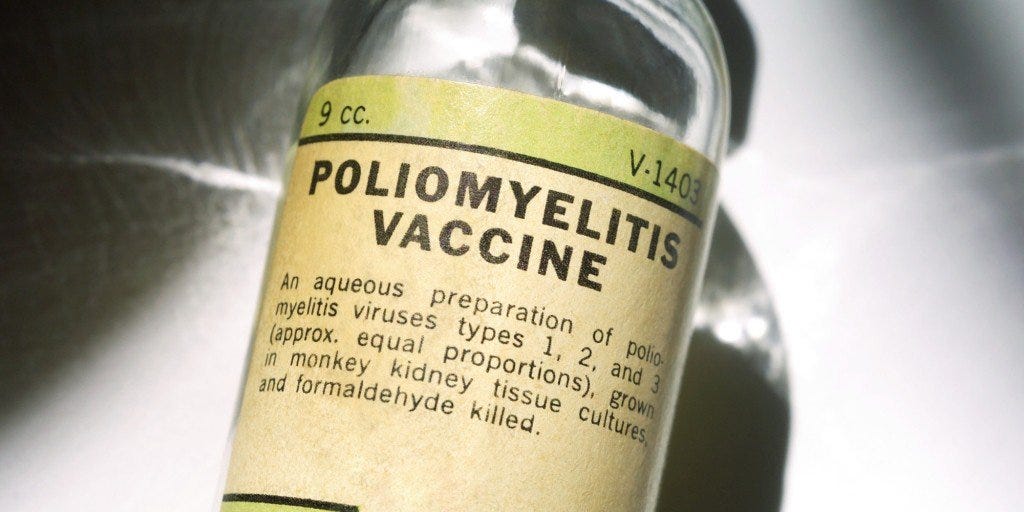The ‘specter of polio’ has once again been put into the consciousness of already-frightened parents. This week, on March 23, the Strategic Advisory Group of Experts on vaccines (SAGE) convened in Geneva, Switzerland to discuss a variety of topics, including polio eradication. And, even though only 23 positive samples with polio viruses were identified during the month of March in the entire world, and ZERO reported cases of paralysis - the 2023 annual Global Polio Eradication Initiative (GPEI) budget was approved at the meeting. What could these very poor countries do with $1,050,000,000 rather than using it to permanently eliminate the last remaining polioviruses from the planet?
It seemed like a good time to repost the review I wrote a while back for my sister news site, Vaxxter.com, on book The Virus and the Vaccine. This important book took the authors 9-years to research and write has long been one of my favorite “go to” books on the story of polio and how the government actively suppressed information about the vaccine they did not what the public to know. (imagine that…) Take some time to read through this, then I encourage you to add this book to your personal library.
+++++++++++++++++++
THE VIRUS AND THE VACCINE, by Debbie Bookchin and Jim Schumacher, is an impeccably researched expose’. Beyond documenting the historical saga of the polio vaccine and the monkey contaminant SV40, the book has a much larger and more foreboding message.
The authors definitively connect the incestuous interrelationships between the federal government, the major governmental health agencies [the Food and Drug Administration (FDA), the National Institutes of Health (NIH), the Centers for Disease Control (CDC) and the National Cancer Institute (NCI)] and the pharmaceutical industry. If there were ever any misgivings as to how deeply enmeshed these groups are, this book removes all doubt. The authors’ impeccable research exposes the extensive use of power, coercion, and cover up used to maintain the public’s “confidence in vaccines.” The political charade created by the polio vaccine in the 1950 has been used repeatedly for every vaccine that has been released since that time.
It goes something like this:
A researcher documents a serious problem with a vaccine.
The government publishes a “definitive study” to “set the record straight.”
A flurry of media campaigns and medical journal articles are paid for to ensure the conclusions of the “definitive study” support the continued use of the vaccine.
Upon critical examination, the “definitive study” is found to have serious flaws. Although broadcast via many venues— government hearings, journal publications, radio broadcasts and over the internet—the rebuttals are barely acknowledged. The “definitive study” becomes “established medical fact.”
Pressure from public watchdog groups is placed on Congress to force the hand of the government agencies.
Hearings are held to give the appearance of concern. But instead of acting quickly and decisively, government committee meetings are used to delay a recall of the poison by using the excuse, “temporal association does not prove causality.”
Identifying a problem: Dangerous to your career
In 1959, researcher Dr. Bernice Eddy, from the National Institutes of Health (NIH), the Division of Biological Standards (DBS) was working with Dr. Sarah Stewart from the National Cancer Institute (NCI). Together, the two proved that a mouse virus could cause cancer when injected into other small animals. Both researchers received national recognition for their discovery and Stewart’s reward including being put in charge of her own laboratory at the NCI.
Upon returning to the DBS, Eddy began to question if the simian viruses found in the monkey tissue cultures used to grow polioviruses could possibly do the same thing [cause cancers]. Acting on her own, she set up an experiment using cell cultures from monkey tissue. She injected the monkey serum into hamsters and to her surprise, she found that nearly 70% of the animals developed tumors. After several more rounds of experiments, she knew that she had discovered a deadly contaminant in the monkey tissue cultures. Alarmed, she knew she needed to do something about it. However, when she approached her boss, Dr. Joe Smadel, with her findings, her concerns were less than welcomed.
Smadel was one of the vaccine’s staunchest defenders. At one time, after the Cutter vaccine had caused a polio outbreak, a congressional committee had considered completely withdrawing the Salk vaccine from the market. It was the “persuasiveness of Smadel’s testimony and his stature in the world of virology that convinced the panel not to cancel the vaccine program outright.” (p. 63)
Rather than praising Eddy for her discovery and her concern, and demanding more NIH funding for further research into the polio vaccine prior to releasing it to the general public, Smadel responded with intense anger. The last thing that the NIH, the federal government—and the pharmaceutical houses—wanted to hear was information that might scare people away receiving the vaccine.
Instead of being rewarded, her discovery eventually cost her her laboratory, her staff, her position, and essentially her career as a serious investigator. This sent a chilling message to other investigators: Research on the connection between SV40 [the monkey virus she had identified,] the polio vaccine and cancer will be dangerous to your future.
This same message is being sent today to researchers investigating the possible connection between vaccines and autism, and the irrefutable connections between covid shots and along list of health concerns.
Do not blame the vaccine
Dr. Andrew Wakefield was a pediatric gastroenterologist whose research at the Royal Free Hospital in London had received many commendations. In 1997, he received a few calls from parents who reported their child was normal before receiving the MMR vaccine and subsequently, lost their verbal skills and became autistic. Their symptoms included bloating, pain, diarrhea, and weight loss.
Dr. Wakefield and a team of others developed a hypothesis that perhaps when the measles virus was given in combination with two other live viruses (mumps and rubella), the gut was somehow damaged in certain, susceptible children. Colonoscopies were performed on 12 children who appeared to be suffering from a new form of inflammatory bowel disease. The results were published in The Lancet in 1998 (Lancet 351:637-641), as a case report, suggesting that “further investigations are needed to examine the possible association between the syndrome of ileolymphoid hyperplasia and the MMR.”
From that point forward, Dr. Wakefield has been villainized by the world. The Royal Free Hospital eventually fired him, and he has been publicly flagellated in medical journals, in media interviews, and within the mainstream press for more than 25 years. Global Departments of Health and all government bodies continue to emphasize the safety of MMR while pouring scorn on the research of anyone who disagrees.
Doctors and researchers, who insist on talking off the record with understandable caution state, ''We've all seen what happened to Andrew Wakefield, and we don't want our careers destroyed.''
The "Definitive Study" to prove SV40 doesn’t cause cancer
By 1963, nearly half of the American population had received the Salk polio vaccine and the NIH’s own research had established the potential of SV40 to cause cancer. Faced with a potentially disastrous public health crisis, a massive epidemiological study to assess whether SV40 was actually causing cancer in the Salk vaccine recipients needed to be done.
The daunting task fell on the shoulders of a young physician who came to work at the National Cancer Institute in the summer of 1962. Joseph Fraumeni, MD was preparing for a career in clinical medicine when he received an offer to work for the NCI. He was hired to become the principal investigator for the office of epidemiological studies, yet by his own admission, he stated:
“I knew nothing about statistics or epidemiology when I started there.” In addition, he knew frightfully little about SV40. (p111)
With the help of biostatisticians from the NIH and the NCI, the study was designed to determine if there had been a statistically significant rise in cancer in children 6-8yo who have been vaccinated during the May and June of 1955. Three types of cancer were surveyed. The study, published in The Journal of the American Medical Association in 1963 (JAMA 185(9):713-718) concluded,
“No significant alterations in mortality rates for cancer had been found and the cancer mortality rates appeared to be unaffected.”
Henceforth, the Fraumeni study became landmark study that, for the next 30 years, would be quoted as conclusively proving that SV40 was a “moot issue” as a cancer-causing agent.
“Especially with the passage of time, most physicians stopped worrying that they might have harmed their patients with tainted Salk vaccine. Future generations of medical practitioners, if they learned about SV40 at all during their medical training, would find it related to them as a novel bit of medical history—an odd virus that had once contaminated the polio vaccine, but had proved to be inconsequential. Indoctrination within the medical establishment about the putative harmlessness of the virus had begun.” (p.113-14).
Fraumeni’s flawed study
It was many years before the flaws in Fraumani’s study were thoroughly examined, although the study’s investigators admitted several at the outset. For example, the children were only followed for four years and certain types of SV40 cancers can take many years to develop. Only cancer deaths—not cancer diagnoses—were included, meaning children diagnosed with cancer but still alive at the time of the study were excluded. Only three types of cancers were surveyed: brain, kidney, and connective tissue. Therefore, other types of cancer associated with SV40—mesothelioma, bone, leukemias, and lymphomas—were not included.
The most glaring flaws had to do with the cohort assignment. The number of children ages 6 to 8 were estimates and an assumption was made that none of the children had moved from state to state. In addition, it was impossible to actually know who got the contaminated vaccines and who did not. Therefore, the cohort assignment, the cornerstone of epidemiological research, was completely flawed, making the conclusions highly suspect at best and completely accurate at worst.
In spite of these blatant inaccuracies, the Fraumeni Study remained “established medical fact,” and the definitive word that exposure tos contaminated polio vaccine did not result in cancer. This study was quoted in every article and in every textbook, without question, for more than 30 years.
The Next Generation of SV40 Research
In the 1990s, SV40 research was resumed by Dr. Michele Carbone. A prestigious virologist, Carbone proved the connection between SV40 and mesothelioma, a rare cancer of the lung pleura thought mainly to be caused by asbestos. His research, published in Nature Medicine in July 1997, was the first of many studies published in Italy, Germany, and the USA showing the association between SV40 and human cancers.
As his work progressed, the Viral Epidemiological Branch (VEB), a division within the NCI, published two additional “definitive studies” meant to dissuade all residual concerns about the connection between SV40 and cancer. The first was published in 1997 by Shah, et. al. in the Journal of Infectious Diseases (J.Inf.Dis 176:1618-21). The study, which was subsequently referred to at the VEB Study, concluded there was “no demonstrable connection between SV40 and human cancers.” This study became the primary weapon in the federal government’s efforts to cast doubt on the association.
Like the Fraumeni study, an analysis of the research shows that the data is inherently flawed, making the conclusions at best worthless; at worst, deceptive. The public was misled into believing that SV40 is not a health threat. The scientific community was also misled into believing that no further research was necessary. Wanting to form a united front, when one branch of government turns out a study that other branches champion its conclusions.
Another “definitive study”: The Danish Study
One of the most hotly contested arguments that has long been debated was the presence of thimerosal in vaccines. Thimerosal is a preservative which is composed of 49.6% ethylmercury, a known neurotoxin.
The government’s latest “definitive study” used repeatedly in arguments to dismiss any causality between thimerosal and autism is referred to as The Danish study. This epidemiologically based study was designed to examine “whether discontinuing the use of thimerosal-containing vaccines led to a decrease in the incidence of autism.”
The conclusions of the study state,
“The discontinuation of thimerosal-containing vaccines in Denmark in 1992 was followed by an increase in the incidence of autism. Our ecological data do not support a correlation between thimerosal-containing vaccines and the incidence of autism.” (Pediatrics 2003;112:604–606)
The flaws continue
Similar to the Fraumeni study, an in-depth analysis revealed three major flaws:
Autism counts [in Denmark] were first based on hospitalized, inpatient records and then changed in the middle of the study to include outpatient records.
Mercury levels [in the Danish studies] were substantially lower and the shots were given later than those scheduled in the U.S. in the 1990s.
Between 1970-92, the only childhood vaccine given in Denmark before 5 months of age was the monovalent pertussis vaccine. In the United States in the 1990s, children were exposed to multiple doses of DTP, polio, hepatitis B and Haemophilus influenza B (Hib) vaccines before five months of age, all containing thimerosal. (adapted from an analysis by Mark Blaxill, Director, www.safeminds.org)
In spite of these flaws, which make the analysis of the data inconclusive, the FDA, the CDC, the American Academy of Pediatrics (AAP) and the Institutes of Medicine (IOM) all site the study as the “definitive study” that conclusively proves there is no connection between thimerosal and autism.
Foot dragging
Knowing that since the 1960s a vaccine contained a cancer-causing virus, how was this allowed to happen? Mostly, it revolves around the cavalier attitude within the federal agencies charged with vaccine safety:
• In 1961, the Division of Biological Standards allowed contaminated lots to be distributed
• Two years were allowed to pass as ‘safety regulations’ were implemented that required manufacturers to insure the polio vaccines were free from SV-40 before release
• No recall was issued of the lots known to be contaminated
• Softening manufacturing regulations to allow production of less expensive shot technology
No product recall for SV40-contaminated vaccines
In 1961, the Technical Committee on the Poliomyelitis Vaccine met to discuss the safety of the existing Salk vaccine. It was concluded that “no untoward effects” had been attributed to the SV40 virus known to be in the vaccine and the SV40 virus was “assumed to be harmless.” The committee recommended no change in the current vaccination policy. Vaccinations should continue using the present stocks and until all the contaminated vaccine was used up.
“The first official health decisions had been made…there would be no recall of old vaccine containing SV-40. Millions of children would continue to receive live SV-40…as the nation’s polio program was simply ‘too important’ to interrupt. There would be no announcement to suppliers and physicians to stop administering SV-40 contaminated vaccine. And there would be no warning to consumers that the vaccine injected into their children contained a live monkey virus whose full effects on humans was entirely unknown.
US citizens were not going to be afforded the chance to decide for themselves whether they were willing to be exposed to SV40; the government had decided that they would.” (p. 93.)
No product recall of thimerosal-containing vaccines either
On July 7, 1999, a recommendation was made by the FDA for the immediate reduction or elimination of thimerosal from infant vaccines. This announcement came after a two-year investigation, prompted by the FDA Modernization Act, which found infants may have been exposed to mercury in excess of Federal Safety Guidelines from routinely administered infant vaccines.
All members involved—including American Academy of Pediatrics (AAP), the FDA, the Centers for Disease Control (CDC) and some vaccine manufacturers—stated that they were making the recommendation to “alleviate the possible concerns” regarding thimerosal, but denied that thimerosal had a causal association with autism.
The manufacturers were not ordered to remove the products currently on the market that contained thimerosal, only to create future products that were “thimerosal-free.” Therefore, children continued to receive thimerosal-containing vaccines for at least two additional years.
In 2004, the CDC recommended infants only six months of age were to receive their first flu shot. Multi-dose influenza vaccines still contain 25mcg of thimerosal per dose.
Summary
These are a few of the highlights found in The Virus and The Vaccine. This impeccably documented book provides information that unequivocally shows the mechanisms used today by government agencies and committees to ignore, diminish and dismiss concerns about vaccination are long-standing. Is it any wonder that public watchdog groups, vaccine activists, and concerned parents and physicians seem to make little headway when attempting to affect the problems associated with mandatory vaccination?
Because vaccination is a part of routine healthcare for people of all ages, The Virus and The Vaccine is a “must-read” for everyone. Approximately 77,500 children born each week in the US. Every parent, faced with the decision regarding vaccination, assumes that the vaccines have been proven to be safe and the governmental agencies regulating vaccines have their best interest in mind. However, The Vaccine and the Virus documents the real truth.
However, a shift is occurring: More and more people are questioning the safety and efficacy of ALL vaccines, not just the covid jabs. The information provided in this fully researched book should cause everyone—parent and healthcare providers alike—to reevaluate their trust in the vaccines, their blind confidence in the governmental agencies who control them, and the physicians that administer them.
For more detail, check out the polio course I created, available at Learning4You.org.













Thank you for sharing. I’m a recovering nurse of repeating “safe and effective” and complete trust in the medical community. Heart breaking
I first discovered this study in the NIH National Library of Medicine in July-August, 2020 when I searched the keywords, "PCR" and "vaccine." There were many studies available, including this one. And when I added "influenza" many more appeared, though most results were about vaccinating horses for influenza. Those studies demonstrated that the flu vaccine itself can be identified as the source of an outbreak of influenza in horses. Specific vaccines from specific years, all with unique identifiers.
Just like in this study that demonstrated that specific polio vaccines are identified in PCR assays. I knew then, July-August, 2020 that vaccines would drive the pandemic, not end it. Called a conspiracy theorist at the time. But I followed the Science. And have learned sooo much more since, about all vaccines, and what they really are. This study is just about a small part of your piece. But I believe it to be corroborating evidence. And I'm interested in your thoughts? And a theory I have that the Covid varients are actually from the vaccines themselves. My suspicion that Delta, Omicron, most all of them could be traced back to specific vaccines if the PCR tests were configured to detect the unique identifiers. And the possibility that even the ordinary seasonal flu itself can be identified and traced to a specific flu vaccine design. A working hypothesis.
Nearly Constant Shedding of Diverse Enteric Viruses by Two Healthy Infants
Journal of Clinical Microbiology, November, 2012
https://www.ncbi.nlm.nih.gov/pmc/articles/PMC3486243/
"In order to determine the extent of viral infections occurring in early childhood, longitudinally collected stool samples from two siblings who grew up in the mid-1980s in the United Kingdom were tested using an extensive panel of PCR primers against 15 groups of viruses to measure the overall frequency and duration of viral shedding."
...
"Child 1...The first trivalent oral poliovirus vaccine (tOPV) was given at day 107. Poliovirus vaccine strain Sabin-2 (HEV-C species) was identified in the first sample analyzed from day 116, and the shedding continued until day 180 (73 days after tOPV administration)."
...
"child 2..."Following tOPV administration on day 129, poliovirus vaccine strain shedding was recorded until day 183, starting with the first collected sample on day 142. Poliovirus (PV) shedding therefore lasted for 54 days after the first tOPV administration."
...
"The availability of frequently collected fecal samples allowed a detailed analysis of viral shedding occurring during the first year of life in two infant sibling from a developed country. A total of 92% of the 72 samples analyzed contained at least one human virus, with some samples containing up to five different viruses. The average fecal samples contained 1.8 viruses. While symptoms requiring hospitalizations were not observed in these two infants, some of the minor signs of infections, such as runny nose and loose stools, frequently seen in infants of that age, may have been caused by these viral infections or coinfections."
...
"The surprisingly high rate of virus detection reported here may still represent an underestimate of viral shedding due to viruses being below levels of detection of the PCR assays used. The intermittent detections seen for the more persistent infections, including HPBV-GI, HPeV-1, HPeV-6, and HBoV-1, may indeed reflect fluctuation of the viral loads below detection levels. Other missed infections may also have resulted in very transient shedding occurring between the nearly weekly collected sampled analyzed here.
Our study showed that two healthy infant siblings were nearly constantly shedding a wide range of enteric viruses during their first year of life. While only two children were analyzed, their customary upbringing indicates that the diversity and duration of enteric viral shedding observed here may reflect that of typical infants in developed countries. Testing of longitudinally collected samples from a larger number of infants will be required to further substantiate this conclusion.
The high number of different infections and in some cases their long-term persistence detected here by PCR show that as more sensitive methods of viral detection are used, an increasing number of asymptomatic infections can be detected, likely reflecting effective passive and/or active immunity in generally healthy infants. The possibly substantial effect on the education of these infants' immune systems of such frequent and long-lasting viral infections, including protection from subsequent challenges with closely related viruses, remains to be determined."
I invite readers to visit https://www.ncbi.nlm.nih.gov/ and do their own keyword search for research like this.
Note: All research found in search returns needs to be validated. Many authors take shortcuts, misinterpret data or other sources, have agendas. Seeing who funded it is a quick indicator, but often times you must go back and read the research they cite to ensure they are presenting it accurately. To do good research you've got to follow a lot of footnotes and use your head. But it's not rocket science that requires university taught expertise.